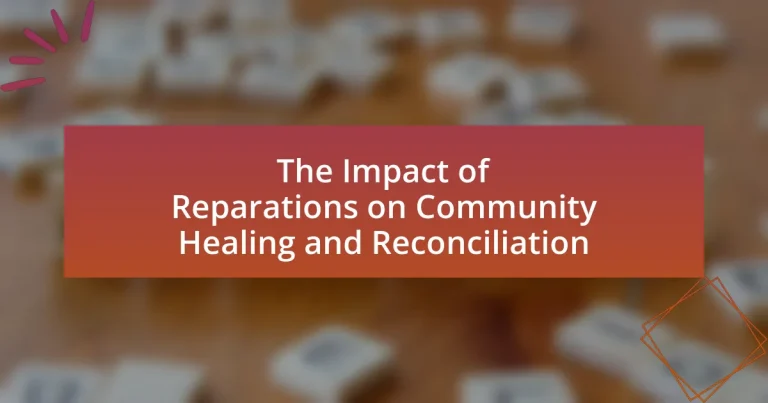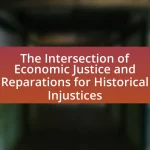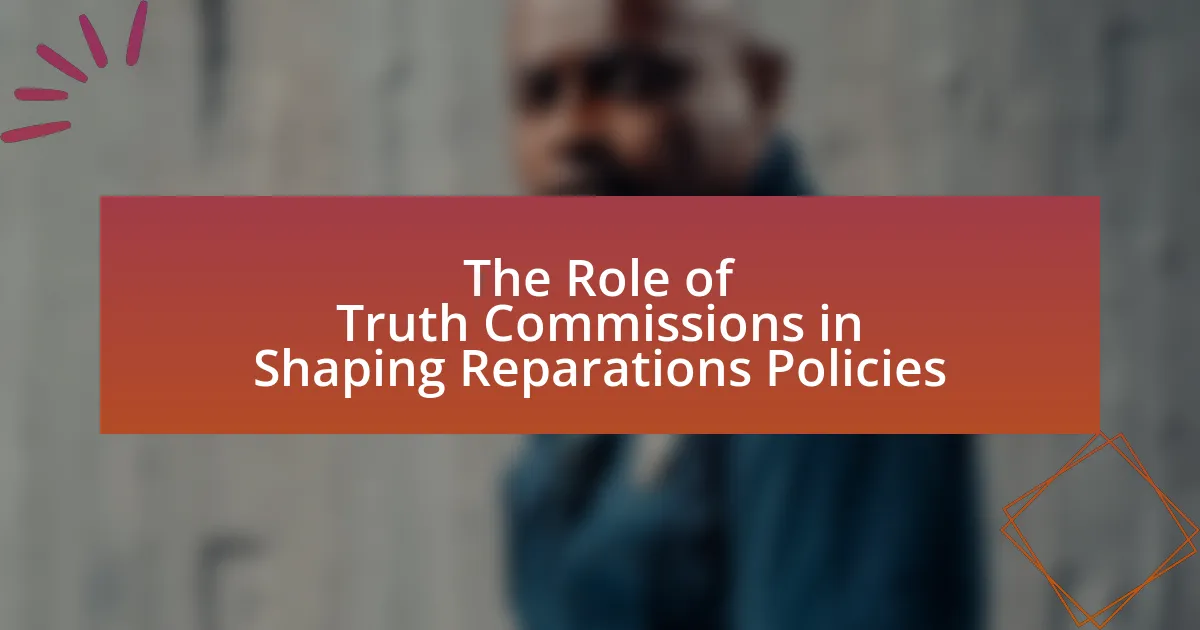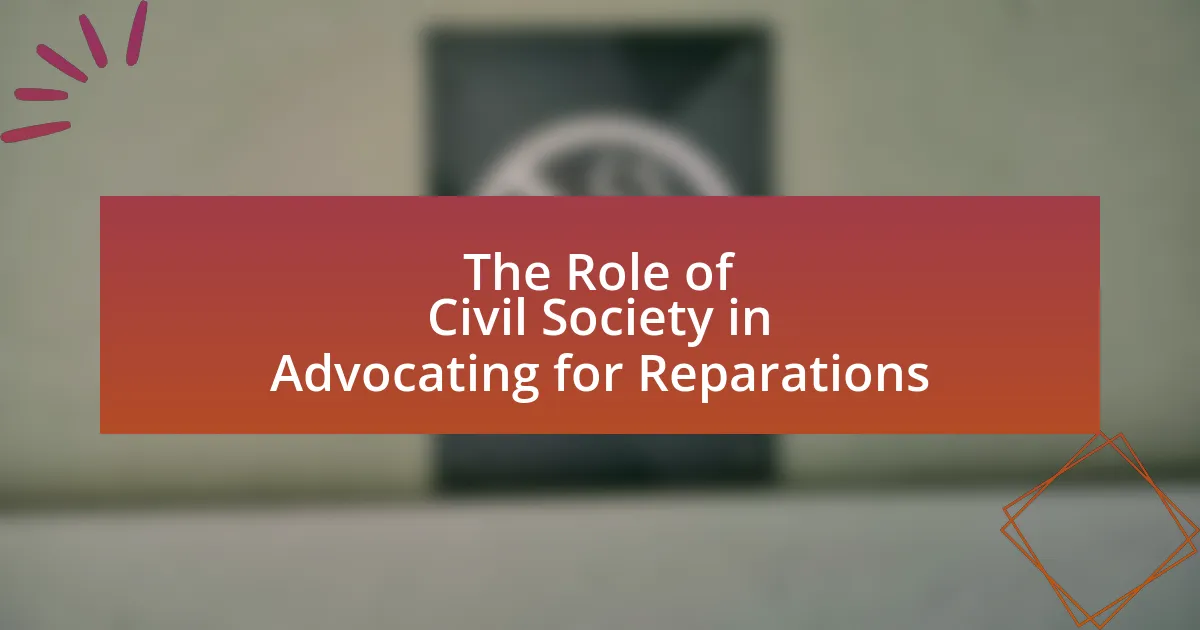Reparations are compensatory measures aimed at addressing historical injustices and systemic inequalities faced by marginalized groups, particularly in the context of slavery, colonization, and discrimination. This article explores the purpose of reparations, emphasizing their role in community healing and reconciliation by acknowledging past wrongs and providing resources for recovery. It discusses various forms of reparations, including financial compensation and non-financial initiatives, and examines their impact on psychological well-being, social cohesion, and economic stability within affected communities. Additionally, the article addresses the challenges associated with implementing reparations, societal attitudes, and the importance of community involvement in shaping effective reparative measures.
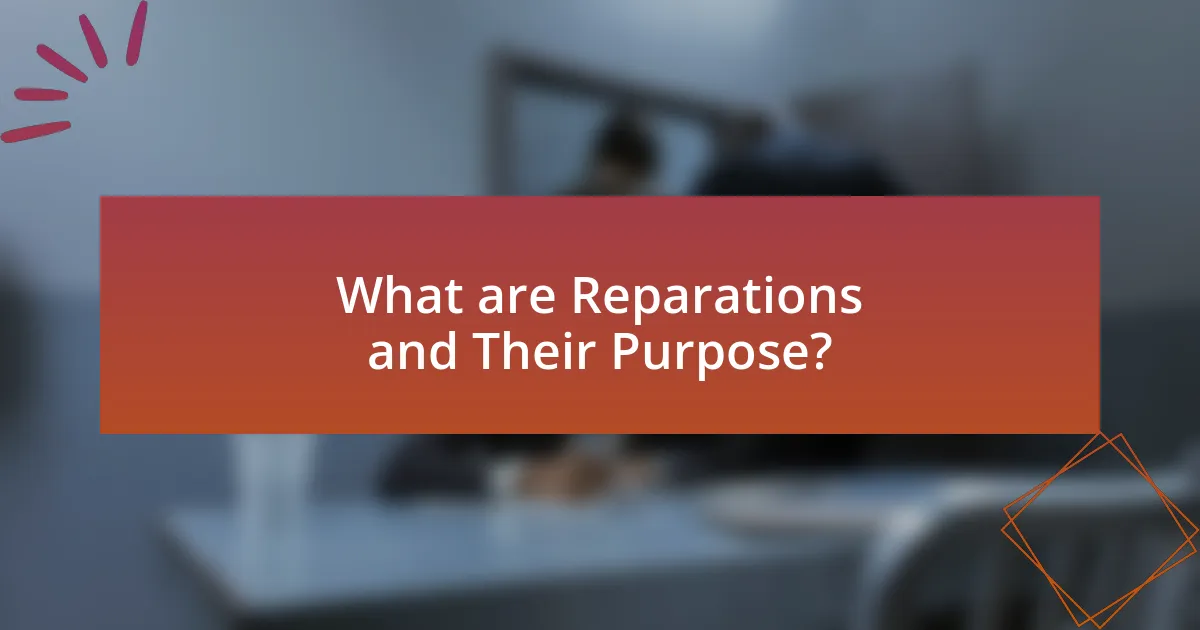
What are Reparations and Their Purpose?
Reparations are compensatory measures taken to address historical injustices and systemic inequalities faced by marginalized groups, particularly in the context of slavery, colonization, and discrimination. Their purpose is to acknowledge past wrongs, provide restitution, and promote healing and reconciliation within affected communities. For instance, the U.S. government has considered reparations for African Americans to address the legacy of slavery and ongoing racial discrimination, aiming to rectify economic disparities and foster social equity. Studies, such as those by the National Academy of Sciences, indicate that reparations can lead to improved community relations and psychological well-being among affected populations, reinforcing the importance of addressing historical grievances for societal progress.
How do Reparations contribute to Community Healing?
Reparations contribute to community healing by addressing historical injustices and providing resources for recovery and empowerment. By acknowledging past wrongs, reparations foster a sense of validation among affected communities, which is essential for emotional and psychological healing. For instance, studies have shown that reparative measures, such as financial compensation or community investment, can lead to improved mental health outcomes and social cohesion. The 2020 report by the National Commission on Reparations highlighted that communities receiving reparations experienced increased trust in institutions and enhanced community engagement, demonstrating the tangible benefits of reparations in promoting healing and reconciliation.
What historical injustices do Reparations address?
Reparations address historical injustices such as slavery, colonialism, and systemic racism. These injustices have resulted in significant economic, social, and psychological harm to affected communities. For instance, the transatlantic slave trade forcibly displaced millions of Africans, leading to generational poverty and disenfranchisement that persists today. Additionally, colonial practices stripped indigenous populations of their land and resources, causing long-term cultural and economic disruption. Studies, such as those by the National Academies of Sciences, Engineering, and Medicine, highlight the ongoing disparities in wealth and health outcomes linked to these historical injustices, reinforcing the need for reparative measures to promote healing and reconciliation within communities.
How do Reparations promote psychological healing in communities?
Reparations promote psychological healing in communities by acknowledging historical injustices and providing a pathway for restorative justice. This acknowledgment helps to validate the experiences of marginalized groups, fostering a sense of recognition and dignity. Research indicates that reparations can lead to improved mental health outcomes by reducing feelings of trauma and disenfranchisement. For example, the 2021 report by the National Commission on Reparations highlights that communities receiving reparative measures often report increased social cohesion and collective resilience, which are essential for psychological recovery. By addressing past harms, reparations facilitate a healing process that empowers individuals and communities to move forward.
Why is Reconciliation important in the context of Reparations?
Reconciliation is crucial in the context of reparations because it fosters healing and restores relationships between affected communities and those responsible for historical injustices. This process allows for acknowledgment of past wrongs, which is essential for building trust and facilitating dialogue. For instance, the Truth and Reconciliation Commission in South Africa demonstrated that addressing grievances through open discussions can lead to societal healing and a shared understanding of history. By promoting forgiveness and understanding, reconciliation enhances the effectiveness of reparations, ensuring that financial or material compensation is not merely transactional but contributes to long-term community restoration and unity.
What role does forgiveness play in the reconciliation process?
Forgiveness is a crucial element in the reconciliation process as it facilitates healing and restores relationships between individuals or groups affected by conflict. By allowing individuals to let go of resentment and anger, forgiveness creates an environment conducive to dialogue and understanding, which are essential for rebuilding trust. Research indicates that communities that engage in forgiveness during reconciliation efforts experience lower levels of ongoing conflict and greater social cohesion. For instance, a study published in the Journal of Conflict Resolution highlights that forgiveness can significantly reduce the psychological burden of past grievances, thereby promoting a more harmonious community dynamic.
How can Reparations facilitate dialogue between communities?
Reparations can facilitate dialogue between communities by acknowledging historical injustices and fostering a sense of accountability. This acknowledgment creates a platform for open discussions about the past, allowing affected communities to express their grievances and experiences. For instance, the implementation of reparative measures, such as financial compensation or community investment, can serve as a catalyst for conversations about systemic inequalities and shared histories. Research indicates that reparations can lead to improved relationships between communities by promoting understanding and empathy, as seen in cases like the South African Truth and Reconciliation Commission, which aimed to heal divisions post-apartheid through dialogue and reparative justice.

What are the Different Forms of Reparations?
Different forms of reparations include financial compensation, land restitution, public apologies, and institutional reforms. Financial compensation provides monetary payments to individuals or communities affected by injustices, such as slavery or colonialism. Land restitution involves returning land to displaced communities, addressing historical grievances related to land dispossession. Public apologies serve to acknowledge past wrongs and foster healing, while institutional reforms aim to change policies and practices that perpetuate inequality. These forms of reparations are supported by various historical precedents, such as the reparations paid to Holocaust survivors and the land restitution efforts in South Africa post-apartheid, which illustrate their potential to promote community healing and reconciliation.
How do Financial Reparations impact communities?
Financial reparations positively impact communities by providing economic resources that can address historical injustices and promote social equity. These funds can be utilized for community development projects, education, healthcare, and infrastructure improvements, which contribute to the overall well-being of marginalized groups. For instance, a study by the Institute for Policy Studies found that reparations can lead to increased economic stability and reduced poverty rates in affected communities, thereby fostering a sense of empowerment and social cohesion. Additionally, financial reparations can facilitate healing by acknowledging past wrongs and promoting dialogue, which is essential for reconciliation and building trust within communities.
What are the potential economic benefits of Financial Reparations?
Financial reparations can provide significant economic benefits by addressing historical injustices and promoting wealth redistribution. These reparations can stimulate local economies through increased spending power among affected communities, leading to enhanced business growth and job creation. For instance, a study by the Institute for Policy Studies found that reparations could reduce the racial wealth gap, which currently shows that White families have approximately ten times the wealth of Black families. By investing in education, healthcare, and housing within these communities, financial reparations can foster long-term economic stability and growth. Additionally, reparations can contribute to social cohesion, which is essential for sustainable economic development, as communities that feel acknowledged and supported are more likely to invest in their local economies.
How do communities perceive Financial Reparations?
Communities perceive financial reparations as a necessary step towards addressing historical injustices and promoting healing. Many community members view reparations as a form of acknowledgment for past wrongs, particularly in contexts of systemic racism and economic disenfranchisement. Research indicates that financial reparations can foster a sense of justice and closure, as seen in studies like the 2021 report by the National African American Reparations Commission, which highlights community support for reparative measures as a means to rectify historical inequalities. Furthermore, surveys show that a significant portion of affected communities believes that financial reparations can contribute to economic empowerment and social equity, reinforcing the idea that reparations are not merely financial transactions but vital components of reconciliation and healing processes.
What non-financial forms of Reparations exist?
Non-financial forms of reparations include acknowledgment of harm, public apologies, memorialization, educational initiatives, and policy reforms. Acknowledgment of harm involves formally recognizing the injustices suffered by affected communities, which can foster healing and validation. Public apologies from governments or institutions serve to express remorse and can facilitate reconciliation. Memorialization, such as monuments or commemorative events, honors the victims and preserves their history. Educational initiatives aim to inform the public about past injustices, promoting awareness and understanding. Policy reforms address systemic issues that contributed to the harm, aiming to prevent future injustices and support affected communities. These forms of reparations have been implemented in various contexts, such as the Truth and Reconciliation Commission in South Africa, which emphasized acknowledgment and education as vital components of healing.
How do educational initiatives serve as a form of Reparations?
Educational initiatives serve as a form of reparations by addressing historical injustices and providing marginalized communities with equitable access to quality education. These initiatives aim to rectify systemic inequalities that have resulted from past discrimination, such as the legacy of slavery and segregation in the United States. For instance, programs like scholarships for underrepresented students and funding for schools in low-income areas directly counteract the educational disparities created by historical injustices. Research indicates that educational attainment is closely linked to economic mobility; thus, enhancing educational opportunities for marginalized groups can lead to long-term socio-economic benefits, fostering community healing and reconciliation.
What role does public acknowledgment play in non-financial Reparations?
Public acknowledgment serves as a crucial component of non-financial reparations by validating the experiences and suffering of marginalized communities. This recognition fosters a sense of dignity and respect, which is essential for healing and reconciliation. Historical examples, such as the Truth and Reconciliation Commission in South Africa, illustrate that public acknowledgment can facilitate dialogue, promote understanding, and help to mend relationships between affected communities and the broader society. By formally recognizing past injustices, public acknowledgment not only honors the victims but also encourages collective responsibility and commitment to preventing future harm.
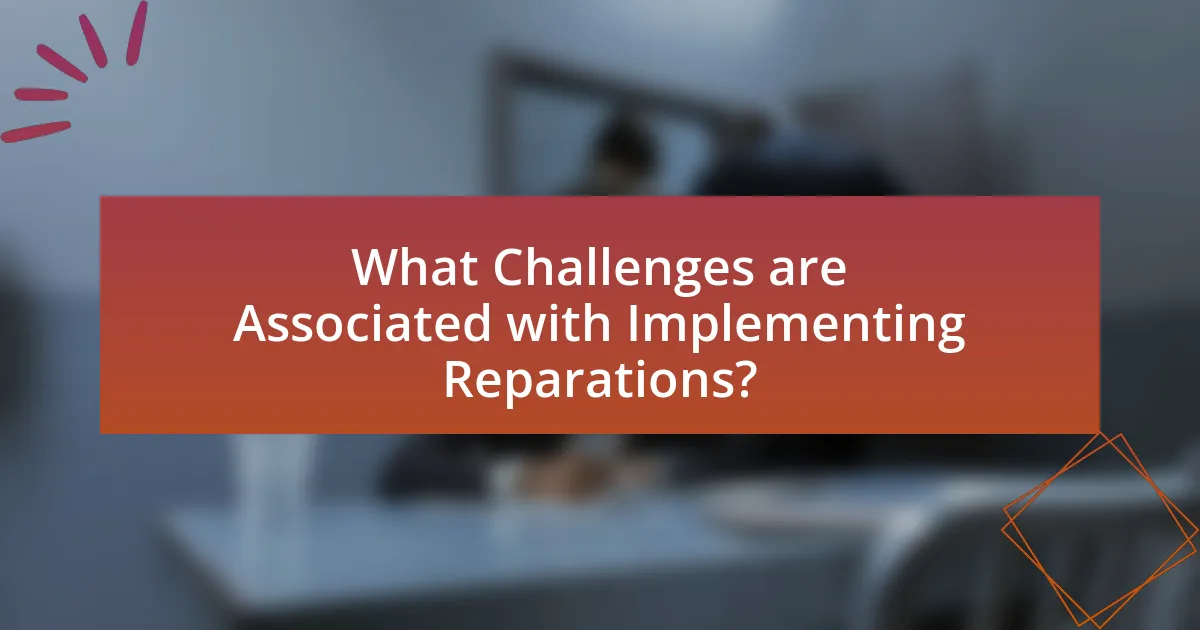
What Challenges are Associated with Implementing Reparations?
Implementing reparations faces several challenges, including political resistance, logistical complexities, and societal divisions. Political resistance often arises from differing views on the necessity and fairness of reparations, with some arguing against financial compensation based on concerns about economic impact or perceived injustice to current taxpayers. Logistical complexities involve determining eligibility, calculating appropriate compensation, and establishing a fair distribution process, which can be administratively burdensome and contentious. Societal divisions manifest as disagreements within communities about the form reparations should take, whether monetary payments, land restitution, or community investments, leading to further polarization. These challenges are underscored by historical precedents, such as the difficulties faced in the implementation of reparations for Japanese Americans after World War II, where compensation was met with significant bureaucratic hurdles and public opposition.
How do societal attitudes affect the success of Reparations?
Societal attitudes significantly influence the success of reparations by shaping public support and political will. When a society acknowledges historical injustices and expresses empathy towards affected communities, it fosters an environment conducive to implementing reparative measures. For instance, surveys indicate that public support for reparations increases when there is widespread recognition of systemic racism and its lasting impacts, as seen in discussions surrounding reparations for African Americans in the United States. Conversely, negative societal attitudes, such as denial of historical injustices or resistance to change, can hinder reparative efforts, leading to insufficient funding and lack of political action. Therefore, the prevailing societal mindset directly correlates with the feasibility and effectiveness of reparations initiatives.
What misconceptions exist about the purpose of Reparations?
One misconception about the purpose of reparations is that they solely involve financial compensation to individuals affected by historical injustices. This belief overlooks the broader objectives of reparations, which include acknowledging past wrongs, promoting healing within communities, and fostering reconciliation between affected groups and society at large. For instance, reparations can also encompass educational initiatives, community investments, and policy reforms aimed at addressing systemic inequalities. Historical examples, such as the reparations paid to Japanese Americans interned during World War II, illustrate that reparations can serve multiple purposes beyond direct monetary payments, including formal apologies and efforts to prevent future injustices.
How can resistance to Reparations be addressed?
Resistance to reparations can be addressed through comprehensive education and dialogue that highlights historical injustices and the benefits of reparative justice. Engaging communities in discussions about the historical context of systemic inequalities, such as slavery and segregation, can foster understanding and empathy. For instance, studies show that educational programs about the impact of slavery on contemporary society can reduce resistance by illustrating the ongoing effects of these injustices. Additionally, involving stakeholders in the reparations process, including those who oppose it, can create a sense of ownership and collaboration, making it easier to address concerns and misconceptions. This approach has been supported by initiatives in various countries where reparations have been implemented, demonstrating that inclusive dialogue can lead to greater acceptance and support for reparative measures.
What legal and political obstacles hinder Reparations efforts?
Legal and political obstacles that hinder reparations efforts include constitutional limitations, lack of political will, and the complexity of establishing eligibility. Constitutional limitations arise from interpretations of the Equal Protection Clause, which can complicate claims for reparations based on historical injustices. The lack of political will is evident in the reluctance of lawmakers to support reparations initiatives, often due to fear of backlash from constituents or political ramifications. Additionally, the complexity of establishing eligibility criteria for reparations can create legal challenges, as it requires a clear definition of who qualifies and the historical context of their suffering, which can be contentious and difficult to navigate. These factors collectively impede the progress of reparations efforts.
How do policy frameworks influence the implementation of Reparations?
Policy frameworks significantly influence the implementation of reparations by establishing the legal, financial, and procedural guidelines necessary for their execution. These frameworks dictate the scope of reparations, including eligibility criteria, types of compensation, and the mechanisms for distribution. For instance, the 2001 South African Truth and Reconciliation Commission provided a structured approach to reparations, which included financial compensation and community development projects, thereby facilitating a systematic process for addressing historical injustices. Furthermore, effective policy frameworks can enhance accountability and transparency, ensuring that reparations are delivered equitably and effectively, as seen in the case of Germany’s reparations to Holocaust survivors, which were governed by specific laws and agreements that outlined the responsibilities of the state.
What role do advocacy groups play in overcoming these obstacles?
Advocacy groups play a crucial role in overcoming obstacles related to reparations by mobilizing public support, influencing policy changes, and providing a platform for marginalized voices. These organizations often conduct research and disseminate information that highlights the historical injustices faced by communities, thereby raising awareness and fostering dialogue. For instance, groups like the National African American Reparations Commission advocate for legislative measures that address systemic inequalities, demonstrating the effectiveness of organized efforts in pushing for reparative justice. Their activities not only educate the public but also pressure lawmakers to consider reparations as a viable solution for community healing and reconciliation.
What Best Practices can enhance the effectiveness of Reparations?
Best practices that can enhance the effectiveness of reparations include community involvement, transparency in the process, and targeted support for affected populations. Engaging communities in the design and implementation of reparations ensures that the measures address specific needs and historical contexts, fostering a sense of ownership and empowerment. Transparency builds trust among stakeholders, allowing for open dialogue and accountability, which are crucial for reconciliation. Additionally, providing targeted support, such as educational opportunities, healthcare access, and economic assistance, directly addresses the systemic inequalities faced by affected groups, thereby promoting long-term healing and social equity. Historical examples, such as the reparations paid to Japanese Americans interned during World War II, demonstrate that these practices can lead to meaningful outcomes when effectively implemented.
How can community involvement shape successful Reparations programs?
Community involvement is crucial for shaping successful Reparations programs as it ensures that the needs and perspectives of affected populations are accurately represented and addressed. Engaging community members in the design and implementation of reparations fosters trust, accountability, and a sense of ownership over the process. For instance, the 2020 report by the National African American Reparations Commission emphasizes that community-led initiatives can better identify specific harms and appropriate reparative measures, leading to more effective outcomes. Additionally, historical examples, such as the reparations programs in Germany for Holocaust survivors, demonstrate that inclusive dialogue and community participation can enhance the legitimacy and acceptance of reparations efforts.
What lessons can be learned from successful Reparations initiatives worldwide?
Successful reparations initiatives worldwide demonstrate that comprehensive acknowledgment of historical injustices is crucial for community healing and reconciliation. For instance, the Truth and Reconciliation Commission in South Africa highlighted the importance of public acknowledgment and dialogue in addressing past atrocities, which facilitated a national healing process. Additionally, the reparations program for Japanese Americans interned during World War II, which included financial compensation and formal apologies, illustrates that tangible reparations can restore dignity and foster trust between marginalized communities and the state. These examples underscore that effective reparations require a combination of acknowledgment, financial compensation, and ongoing support to promote long-term healing and reconciliation.
